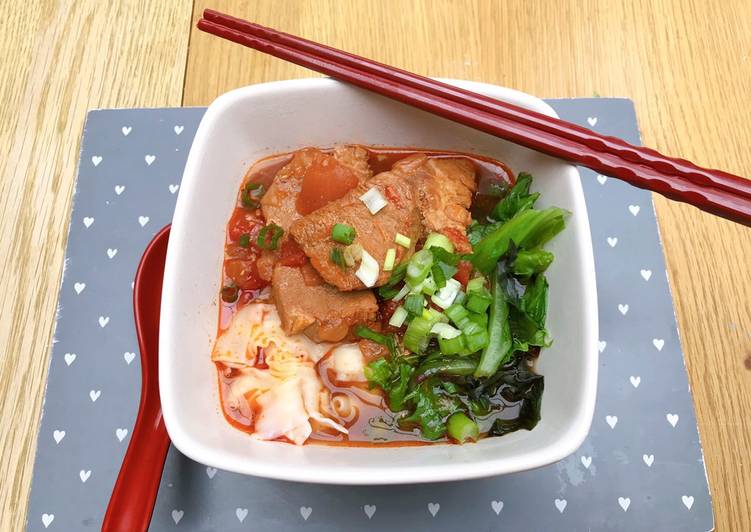
Hello everybody, it is Louise, welcome to my recipe page. Today, I will show you a way to make a distinctive dish, taiwanese braised pork noodle soup. It is one of my favorites food recipes. This time, I am going to make it a bit tasty. This will be really delicious.
Taiwanese braised pork noodle soup is one of the most popular of recent trending foods on earth. It is simple, it’s fast, it tastes yummy. It is enjoyed by millions daily. Taiwanese braised pork noodle soup is something that I have loved my whole life. They are nice and they look wonderful.
Fry in oil, chopped onion, garlic, hot chili pepper, ginger slices, star anise, cinnamon stick and cloves until fragrant. Lower heat, and add brown sugar. Once brown sugar is melted, add pork whole (without cutting) to the pot. Brown pork on all sides, then add sliced Chinese mushrooms to pot.
To begin with this recipe, we must prepare a few ingredients. You can cook taiwanese braised pork noodle soup using 13 ingredients and 8 steps. Here is how you cook that.
The ingredients needed to make Taiwanese braised pork noodle soup:
- Prepare 900 g Pork shoulder
- Prepare 4 Spring onion
- Make ready 1 small chunk Ginger
- Take 1 Onion
- Get 3 cloves Garlic
- Prepare 400 g Tin tomato
- Take 75 ml Rice wine
- Prepare 80 ml Soy sauce
- Prepare 1-2 Tablespoons Lee Kum Kee Chilli bean sauce
- Make ready 3 Tablespoons Caster sugar
- Take 1 Chinese mixed spice pouch
- Get 1000 ml Water
- Get Some Chinese flower noodles
This recipe is based on Taiwanese braised beef noodle soup. Many Taiwanese dishes rely heavily on sauces, spices and pickled greens- this braised noodles soup dish is no exception. Combining herbal and umami flavors, this noodle soup contains numerous spices that make its unique broth savory and rich. Xiao Long Bao, or Soup Dumplings (小籠包) Taiwanese chain Din Tai Fung has become internationally synonymous with soup dumplings, and the original branch in central Taipei consistently draws lines.
Instructions to make Taiwanese braised pork noodle soup:
- Place pork shoulder, 2 spring onion, ginger and 2 Tablespoons of rice wine into a deep pot. Add in cold water to cover the pork. Bring it to boiled and then simmer for 20 minutes. Turn off the heat and let the pork rest in the soup with the lid on for 30 minutes.
- Take the meat out and cut into big chunks (Keep the soup).
- Get a clean frying pan and add some oil. Fry the chopped onion and garlic slices.
- Add in Chilli bean sauce.
- Add in pork, sugar, soy sauce and rice wine and mix them all well.
- Pour the whole tin of tin tomato into the pork soup and add in the spice pouch.
- Pour everything from step 5 into the soup pan and braise for 1 hour.
- Chop 2 spring onion. Boil some noodles and green vegetables and then place them in a deep bowl. Pour in some pork soup and pork. Sprinkle some chopped spring onion on the top. Enjoy. 😋
Combining herbal and umami flavors, this noodle soup contains numerous spices that make its unique broth savory and rich. Xiao Long Bao, or Soup Dumplings (小籠包) Taiwanese chain Din Tai Fung has become internationally synonymous with soup dumplings, and the original branch in central Taipei consistently draws lines. Taiwanese Braised Pork Rice (Lu Rou Fan), sometimes known as Minced Pork Rice, is one of the most popular & iconic Taiwanese street food! There are some variations on the name, ingredients, and cooking methods depending on the region, but generally it's a classic comfort food made with Pork Belly braised in a rich savory-sweet-umami sauce. Heat the oil in a wok over low heat, and add the rock sugar (or granulated sugar).
So that is going to wrap this up for this exceptional food taiwanese braised pork noodle soup recipe. Thanks so much for your time. I’m sure that you will make this at home. There’s gonna be more interesting food at home recipes coming up. Don’t forget to save this page in your browser, and share it to your family, friends and colleague. Thank you for reading. Go on get cooking!

